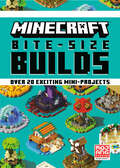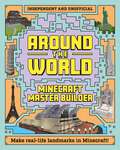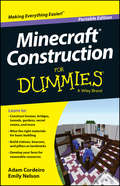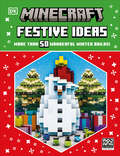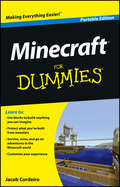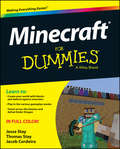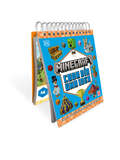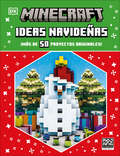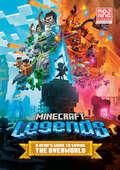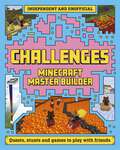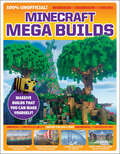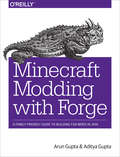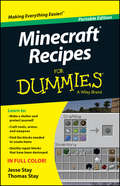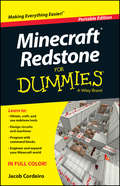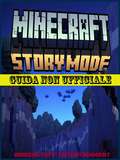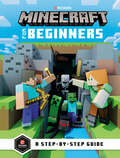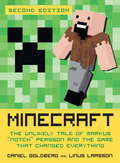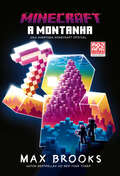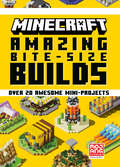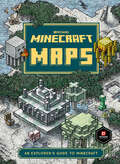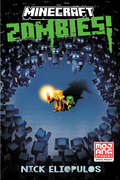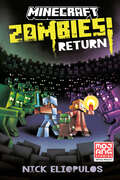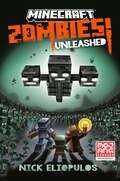- Table View
- List View
Minecraft Bite-Size Builds (Minecraft)
by Mojang AB The Official Minecraft TeamDiscover new and exciting Minecraft builds made easy, broken down into manageable pieces—written in official partnership with the experts at game-creator Mojang.Learn how to design, build and customize 20 mini-projects in Minecraft, from firefighter planes and deep-sea submarines to hidden bunkers and mini arcade games. There's even a superhero flying school! Each build is accompanied by exploded views and step-by-step, fully-illustrated guides and detailed instructions to show you how to complete each build from start to finish. Informative text will help you with your construction understanding and encourage you to use your new knowledge to create your very own builds.
Minecraft Builder - Around the World: Independent and Unofficial
by Mortimer Children's BooksTravel the world in Minecraft! This easy-to-follow guide is filled with detailed instructions on how to make your own versions of the world's greatest landmarks. It includes straightforward instructions on how to build 13 different structures from around the world, including the Statue of Liberty, the Easter Island Heads, Sydney Opera House, Burj Khalifa, the Eiffel Tower, and many more.Builds range in difficulty, so there's something for every reader to try. Plus, every section is filled with cool info about the world's greatest wonders, meaning this is the perfect title for young learners. It's a fantastic way to combine geography, history and creativity into an amazing, fulfilling Minecraft experience.
Minecraft Construction For Dummies
by Adam Cordeiro Emily NelsonAn accessible guide that makes Minecraft construction easyThere isn't anything that can't be built in Minecraft, but it can be overwhelming to figure out where to start. That's why there's Minecraft Construction For Dummies, Portable Edition. More than just a game, Minecraft consists of players using an avatar to create or destroy various types of blocks, form fantastic structures, create artwork, and do much more, all in a three-dimensional environment and across various multiplayer servers in multiple game modes. With this fun and friendly beginner's guide, you will quickly discover how to fine-tune your skills in order to construct almost anything you want in this amazing environment.Provides step-by-step instructions to help you build houses, boats, islands, and moreAddresses how to mine the right materials for basic buildingReveals how to build statues, beacons, and pillars as landmarksExplores how to develop your farm for renewable resourcesMinecraft Construction For Dummies, Portable Edition goes where you go as you create a world you won't want to leave!
Minecraft Festive Ideas: More Than 50 Wonderful Winter Builds
by DKYou won’t run out of building ideas with this magical stocking-stuffer, featuring more than 50 festive building ideas, games, and activities! Packed with inspirational ideas and tips for Minecraft holiday builds, Minecraft Festive Ideas is perfect for creative Minecraft fans who want to build a fun and festive winter wonderland. Building ideas include a gingerbread house, an adorable family of penguins, an arena for a snow golem snowball fight, merry Minecraft challenges suitable for younger players, and much more! © 2023 Mojang AB.
Minecraft For Dummies
by CordeiroCraft yourself an amazing game of Minecraft!More than just a game, Minecraft consists of players using an avatar to create or destroy various types of blocks, form fantastic structures, create artwork, and do much more, all in a three-dimensional environment and across various multiplayer servers in multiple game modes. With this fun and friendly beginners guide, you will quickly grasp how to play Minecraft in the three modes of game play: survival, creative, and hardcore. The easy-to-understand writing style walks you through every step of the way, from downloading the game to choosing a gaming platform to defending your creations against monsters and winning the game by defeating the Ender Dragon.Explains how to use blocks to build amazing creations and engage in gameplay with other playersDetails techniques for travelling across the biomesZeroes in on playing wisely in Survival mode so you can acquire resources to maintain your health and hungerShares tips for playing carefully in Creative mode, using your unlimited supply of resources, the ability to fly, and moreHelps you play in Hardcore modeMinecraft For Dummies, Portable Edition goes where you go as you create a world you won't want to leave!
Minecraft For Dummies
by Jesse StayDon't be a Minecraft tourist - get expert tips and advice in this full-color primerMinecraft For Dummies is the complete guide to playing within the Minecraft world. With easy-to-follow guidance from a team of Minecraft experts, you'll develop programming and engineering skills as you build amazing creations using in-game blocks and mechanical devices. Whether you prefer the PC, console, or portable platform, this helpful guide will walk you through the process of setting up and beginning gameplay, and engage with other users from all around the globe. With this trusty guidebook in hand, you'll navigate the infinite world of Minecraft with confidence, skills, and a storehouse of expert advice.Minecraft is the sandbox construction game that has become a mainstream phenomenon with over a hundred million players. A virtually infinite world and versatile style of play offer endless possibilities for both the hardcore gamer and the total noob, and Minecraft For Dummies shows you everything you need to know before you break your first block.Choose your platform, download the game, and play in all three modesGather resources, place and break blocks, and use circuits and logic gatesDefend your creations against spiders, skeletons, zombies, and the CreeperTravel across the biomes and defeat the enderdragon to win the gameWhether you play to win or just like to explore, there is a style of Minecraft that will spark your imagination. Create or destroy, make war or peace, attack or defend - the game is whatever you want it to be. If you're ready to leave your mark on this digital universe, Minecraft For Dummies is the primer you need to get up to speed.
Minecraft Idea a Day: Packed with Hundreds of Ideas to Inspire You!
by DKDiscover a new Minecraft build idea to inspire you each day!Get creative with 150 awesome Minecraft builds, from secret bases, cute animals, and dream homes, to supersized landmarks, mob builds and much more!Whether it’s a bouncy castle, creeper maze, swamp monster, rainbow bridge, axolotl house, or giant hotdog, each day brings a new and totally random, super-fun surprise. Plus, get top tips on how to level-up your Minecraft building skills.© 2024 Mojang AB.
Minecraft Idea a Day: Packed with Hundreds of Ideas to Inspire You!
by DK¡Pasa las páginas de este libro y encuentra la inspiración cada día con una nueva idea de construcción de Minecraft!Da rienda suelta a tu creatividad con 150 increíbles construcciones de Minecraft, desde bases secretas, animales adorables y casas de ensueño hasta monumentos gigantes y mucho más. Con un formato vertical encuadernado en espiral, es perfecto para ponerlo sobre tu escritorio o mesita de noche, y para pasar un rato divertido con familiares y amigos. Un castillo inflable, un laberinto de enredaderas, un monstruo de pantano, un puente arcoíris, una casa de axolotes o un hot dog gigante…Cada día encontrarás una sorpresa nueva, totalmente aleatoria y súper divertida, además de los mejores consejos para mejorar tus habilidades como constructor de Minecraft.© 2024 Mojang AB.------------------------------------------------------------Flip the page and discover a new Minecraft build idea to inspire you daily!Get creative with 150 awesome Minecraft builds, from secret bases, cute animals, and dream homes to supersized landmarks, mob builds, and much more! The stand-up, spiral-bound format is perfect for displaying next to your screen and enjoying with family and friends as you find inspiration for your next brilliant build.Whether it’s a bouncy castle, creeper maze, a swamp monster, rainbow bridge, axolotl house, or giant hotdog, each day brings a new and totally random, super-fun surprise. Plus, get top tips on how to level up your Minecraft-building skills.© 2024 Mojang AB.
Minecraft Ideas navideñas (Festive Ideas)
by DK¡Encuentra la inspiración con más de 50 ideas de construcción, juegos y actividades de Navidad!Perfecto para los fans más creativos, este libro está lleno de ideas y consejos útiles para llevar a cabo construcciones navideñas del mundo de Minecraft. Construye una casa de pan de jengibre, una adorable familia de pingüinos o una arena para peleas de bolas de nieve con gólems, y enfréntate a los desafíos más divertidos con Minecraft Ideas navideñas.© 2024 Mojang AB.------------------------You won’t run out of building ideas with this magical stocking-stuffer, featuring more than 50 festive building ideas, games, and activities!Packed with inspirational ideas and tips for Minecraft holiday builds, Minecraft Festive Ideas is perfect for creative Minecraft fans who want to build a fun and festive winter wonderland. Building ideas include a gingerbread house, an adorable family of penguins, an arena for a snow golem snowball fight, merry Minecraft challenges suitable for younger players, and much more!© 2024 Mojang AB.
Minecraft Legends: A Hero's Guide to Saving the Overworld (Minecraft)
by Mojang AB The Official Minecraft TeamPrepare for the upcoming Minecraft: Legends video game with this official guide from Mojang, featuring tips, tricks, and strategies to help you defeat the Piglin threat and save the Overworld! The Overworld needs a hero. Is it you? The Overworld is on the brink of destruction. The piglins have arrived, and they&’re hungering to take it for themselves. Gather your strength, inspire unexpected friends and lead them into battle before the piglins&’ Nether corruption devours all. Inside these pages, you&’ll discover game-winning strategies, from combat hacks to building tips, and learn what to expect from the piglin hordes and their bases. This is your ultimate guide to driving the piglins back to the Nether.
Minecraft Master Builder Challenges (Minecraft Master Builder #5)
by Welbeck Children's BooksIf you're playing Minecraft online with friends, you need this cool new collection of amazing Minecraft challenges! This book gives you simple, step-by-step instructions for building amazing arenas, setting up fun quests, and organising server-wide games.Difficulty levels range from easy-to-play games like hide-and-seek and racing, to fun building challenges, and all the way up to huge epic tasks involving all your friends. Best of all, you don't need to mod your copy of Minecraft-all the challenges here can be shared with your friends without any extra downloads or alterations to regular Minecraft. If you're looking to create some spectacular challenges to amuse and amaze your friends, look no further!
Minecraft Mega Builds: An AFK Book (Media tie-in)
by Future PublishingThe perfect guide for any builder that wants to take their Minecraft construction skills to new heights!From weird to awesome, this unofficial guide has it all! With step-by-step instructions you can tackle some of the biggest, wackiest, and coolest Minecraft builds of all time. Whether you are just starting out, trying to perfect your building skills, or searching for inspiration on your next megabuild, you won't want to miss the Minecraft Unofficial Build guide!
Minecraft Modding For Kids For Dummies
by Stephen Foster Lindsey Handley Sarah GuthalsJoin more than 100 million players in the online world of Minecraft Are you a Minecraft fanatic looking to mod your games? Hours of fun await! Minecraft Modding For Kids For Dummies teaches you how to mod in easy-to-do parts. Offering loads of helpful explanations and cool projects along the way, this friendly guide will have you advancing levels, keeping score, respawning players, building portals, creating an archery range'and much more'faster than you can say redstone! There's no denying that modding is cool. After all, it allows you to alter your Minecraft gaming world to constantly keep things new and fun. While it isn't incredibly difficult to learn to mod, it does take some practice. Luckily, Minecraft Modding For Kids For Dummies is here to help you build basic coding skills to make modding your games as easy as 1-2-3! The book is in full color and lies flat so you can look while you play Includes a free trial of the LearnToMod software to use alongside the book Features larger print to make the text feel less daunting Offers next steps you can take if you want to learn even more about modding and coding If you're one of the millions of kids who play Minecraft every day, this hands-on guide gets you up and running fast with modding your favorite game!
Minecraft Modding with Forge
by Arun Gupta Aditya GuptaPlaying Minecraft is a lot of fun, but the game is more engaging, entertaining, and educational when kids learn how to build mods--small programs that let them modify game elements and add content. This family-friendly guide teaches kids and parents how to create mods of different types, using the Minecraft Forge modding tool. No programming experience is needed.You'll not only build some amazing mods with the book's easy-to-follow instructions, but you'll also learn how to work with Java, the same programming language that Minecraft uses. Why wait? Get started with computer programming and be more creative with Minecraft while you're at it!This book will help you:Learn the fundamentals of Minecraft Forge and other tools, such as EclipseStart out by building and testing a simple chat message modBuild cool mods that make things explode on contact, and help entities jump higher and climb wallsIntroduce new Minecraft content, including commands, blocks, items, and recipes and texturesWork with Java fundamentals such as classes, methods, annotations, control structures, and arraysLearn techniques for creating your own modsThis guide is based on workshops the authors deliver to kids around the world.
Minecraft Recipes For Dummies
by Jesse Stay Thomas StayA quick, handy reference on Minecraft recipesWant to find resources, make a shelter, craft tools, armor, and weapons, and protect yourself from monsters with Minecraft recipes? You've come to the right place! In a handy, portable edition that's packed with step-by-step instructions, Minecraft Recipes For Dummies makes it easy to look up the required items and figure out which blocks you need to gather to create each item. You'll get recipes for weapons, armor, transportation, mechanism, food, dye, wool, and brewing, as well as information on enchanting, repairing, gathering, farming, efficiency, and more.Minecraft is more than just a game: it's an obsession. It has gone from an obscure game with a cult-like following to a mainstream phenomenon. Minecraft consists of players using an avatar to create or destroy various types of blocks, form fantastic structures, create artwork, and much more, all in a three-dimensional environment and across various multiplayer servers in multiple game modes. With this fun and friendly guide, you'll get quick and easy access to Minecraft recipes to enhance your game and get even more out of this popular, addictive game.Shows you which blocks you'll need to gather to create shelter, tools, armor, weapons, and moreMakes it easier for both beginner and advanced Minecraft players to make the most of the gamePlaying the game teaches users basic programming skills and engineering conceptsThe author's sons--both avid Minecraft players and bloggers--contributed to the writing of this bookMinecraft Recipes For Dummies is the portable guide that goes where you go as you create a world you'll never want to leave.
Minecraft Redstone For Dummies
by CordeiroThe indispensable primer for achieving redstone greatnessMinecraft Redstone For Dummies is the complete guide to finding, using, and maximizing the power of redstone in the Minecraft world. This key element is essential for crafting and brewing, and can be placed on the ground as redstone dust - a flat, transparent block that can transmit redstone power, the major component of most redstone circuits. Written by a recognized Minecraft expert, this useful guide walks you through mining, smelting, and other methods of obtaining redstone, and teaches you how to make the most of your redstone stores. Craft a compass, piston, lamp, or torch, brew a potion that reverts to Level 1, or turn it to dust to help find nearby power components. Whether you're in Creative or Survival mode, redstone mastery is crucial for successful gameplay.Minecraft is a worldwide phenomenon, boasting over 100 million players from around the world. While gameplay varies according to player preference, redstone remains a central element that allows players to build, brew and create as they advance through the biomes. Minecraft Redstone For Dummies teaches you everything you need to know about redstone, including how to get it and how best to use it.Learn which methods result in more redstone per attemptDiscover how redstone is used in crafting and brewingUse redstone dust to build circuits and power mechanical componentsUnderstand redstone power, including source, levels, and configurationDon't be content to acquire what you stumble across. Redstone's versatility makes it an indispensable resource in the Minecraft world, and knowing where to find it and how to use it efficiently can make all the difference in your gameplay. If you're ready to level up, Minecraft Redstone For Dummies will make you a redstone guru in no time.
Minecraft Story Mode: Guida non ufficiale
by Joshua Abbott A. S.*GUIDA NON UFFICIALE* Guida strategica avanzata e consigli. Questa è la guida più esaustiva e dettagliata che potete trovare su Internet. Disponibile immediatamente sul vostro cellulare, lettore ebook o in formato cartaceo. Dopo il successo delle mie centinaia di altre guide strategiche, ho scritto un'altra guida professionale per i giocatori nuovi e quelli più avanzati. Questa guida offre strategie specifiche e consigli su come andare avanti nel gioco, battere gli avversari, ottenere più monete e molto altro! - Strategie e consigli professionali. - Trucchi - Segreti, consigli, trucchi utilizzati da giocatori professionisti! - Come ottenere molte monete/valuta. - E MOLTO ALTRO! Tutte le versioni di questa guida sono corredate di screenshot per aiutarvi a comprendere meglio il gioco. Non esistono guide più esaustive e avanzate di questa. Attenzione: Questo prodotto non è in alcun modo affiliato, associato, promosso o pubblicizzato dal detentore originale dei diritti d'autore.
Minecraft for Beginners (Minecraft)
by Mojang AB The Official Minecraft TeamCurious about Minecraft, but not sure where to start? This book is just what you need. With its open-ended game play, massive world and dedicated fan base, Minecraft is a richly rewarding experience—once you get the hang of it. With easy-to-follow instructions, tips and tricks from the experts behind the game, Minecraft for Beginners will help you survive and thrive. You&’ll learn how to find food, build a shelter, mine for materials and craft armor, swords and other equipment, plus get the inside scoop on places to go and the monsters you&’ll encounter. What are you waiting for? Begin your Minecraft adventure today! This ebook is best viewed on a color device with a larger screen.Collect all of the official Minecraft books:Minecraft: The IslandMinecraft: The CrashMinecraft: The Lost JournalsMinecraft: The Survivors&’ Book of SecretsMinecraft: Exploded Builds: Medieval FortressMinecraft: Guide to ExplorationMinecraft: Guide to CreativeMinecraft: Guide to the Nether & the EndMinecraft: Guide to RedstoneMinecraft: MobestiaryMinecraft: Guide to Enchantments & PotionsMinecraft: Guide to PVP MinigamesMinecraft: Guide to FarmingMinecraft: Let&’s Build! Theme Park AdventureMinecraft for Beginners
Minecraft, Second Edition
by Daniel Goldberg Linus LarssonThe incredible tale of a little game that shook the international gaming world--now with new material including a behind-the-scenes look at the sale to Microsoft.For this second edition, the story has been enriched with more Minecraft than ever--a new section describes Minecraft's sale to Microsoft, Notch's less than heartwarming last day in the office, and Mojang's final days of independence. His whole life, all Markus Persson wanted to do was create his own games. Create his own games and get rich. Then in 2009 a strange little project of his quickly grew into a worldwide phenomenon and, in just a few short years, turned its maker into an international icon.Minecraft: The Unlikely Tale of Markus "Notch" Persson and the Game that Changed Everything is a Cinderella story for the Internet age--improbable success, fast money, and the power of digital technology to shake up a rock-solid industry. It's a story about being lost and finding your way, of breaking the rules and swimming against the current. It's about how the indie gaming scene rattled the foundations of corporate empires. But, above all, this is the story of how a creative genius chased down a crazy dream: the evolution of a shy amateur programmer into a video game god.
Minecraft: A Montanha
by Max BrooksUMA AVENTURA IMPERDÍVEL DO UNIVERSO MINECRAFT! Ele não sabe o seu nome, nem onde está, nem como sobreviver, nem como voltar para casa. E no mundo de Nether, com uma ajuda preciosa, luta pela vida contra mobs e zombies. Uma lição sobre amizade e sobrevivência.
Minecraft: Amazing Bite-Size Builds (Minecraft)
by Mojang AB The Official Minecraft TeamLearn how to design, build and customize 20 mini-projects in Minecraft, from firefighter planes and deep-sea submarines to hidden bunkers and arcade games. There&’s even a superhero flying school! With detailed instructions, block hacks and build tips, this book will teach you new tricks and help you practice old skills as you create bite-size builds to impress your friends in Minecraft.
Minecraft: An Explorer's Guide to Minecraft (Minecraft)
by Mojang AB The Official Minecraft TeamDiscover the hidden corners of the many weird and wonderful locations in Minecraft with this beautifully illustrated, full-color guide--written in official partnership with the experts at game-creator Mojang.Are you ready for an adventure? Minecraft: Maps is a visual guide to the Minecraft landscape, created by an explorer on a quest to find the most valuable loot while avoiding danger. Explore each of the fifteen major biomes through highly detailed, illustrated maps, then read the explorer's notes about the unique features and discover an inspirational themed build idea for each.A beautifully illustrated visual guide in its own right, Minecraft: Maps is also a survival tool. You'll learn which biomes are home to the most dangerous mobs, where to look for exclusive blocks, how to find naturally generated structures and the best places to search for loot. Once you've discovered each biome you can get building--construct an ice palace in the ice plains biome and an entire village suspended in the tree canopy above the jungle floor.Biomes: Badlands, Dark Forest, Desert, Forest, Jungle, Mountains, Mushroom Fields, Ocean, Plains, Savanna, Snowy Tundra, Swamp, Taiga, The Nether, The End
Minecraft: An Official Minecraft Novel (Minecraft)
by Nick EliopulosMeet the next big thing in the world of official Minecraft novels: zombies!Looking after a little sibling can be a real headache . . . especially when they&’re a zombie trying to eat your brains! Life is good for Bobbie in the sleepy village of Plaintown. Sure, her villager parents only ever say &“Hrm,&” but you pick up the local language quickly. And maybe her little brother, Johnny, is always getting into trouble, but the village&’s iron golem is there to look out for him. And, yeah, things are too busy for exploring when you&’re the only one in town who ever takes their hands out of their sleeves. But maybe that&’s for the best. After all, there are things out there beyond the torchlight that are better handled by adventurers. But one night, a stranger comes to Plaintown—and he&’s followed by a horde of ravenous zombies! Bobbie&’s village is overrun, and her world is turned upside down as her friends, family, and neighbors fall victim to the zombies&’ endless appetite. Life is not so good for Ben, an adventurer with nothing left to his name but the armor on his back. When dawn&’s light shows him an abandoned village, he sees it as a chance to pick through the wreckage and get himself back on track. What he wasn&’t expecting to run into was a desperate girl with a baby zombie villager on a leash. Bobbie and Johnny are the only ones left . . . and her brother&’s a lot greener and a lot bitier than he was last night. There&’s still some of Johnny rattling around the little zombie monster&’s mind; Bobbie just knows it. And Ben might know a way to bring him back.As the two journey across the Overworld, dragging Johnny along (literally), they brave dangerous depths, terrifying mobs, and an expanding mystery. Was the zombie attack on Bobbie&’s village really just bad luck? Where did the rest of the zombies go? And how exactly do you take care of a little brother who can&’t stop trying to eat you? Hold onto your brains—and your bows—and get ready to enter Minecraft: Zombies!
Minecraft: An Official Minecraft Novel (Minecraft)
by Nick EliopulosJust when you thought it was safe to go back into the Overworld, the zombies have returned!Bobbie is on a mission. She&’s already survived one encounter with Logan, the zombie-herding jerk who attacked her village and turned her brother into a zombie. And now she won&’t rest until she stops his evil plan to conquer the Overworld with his zombie horde. But the closer she gets to foiling Logan, the further away she gets from her original goal: finding a cure for her zombie brother.Ben is on . . . babysitting duty. Separated from Bobbie, Ben is now in charge of caring for her zombie-fied little brother, Johnny, and keeping up with his Zombie Obedience Lessons. Lessons that are going well! Johnny doesn&’t even need his leash anymore, and he hardly tries to eat people at all—unless they really, really deserve it. Logan&’s abandoned lair is even starting to feel a little like home.But while doing a little spring cleaning, Ben discovers Logan&’s secret diary, filled with all his biggest plots, including his next target: a legendary hero named Pigstep Peggy. Now, it&’s a race against time. Can Ben track down Bobbie and stop Logan before his zombies feast again? Can they win Peggy over to their cause? Will Johnny ever stop hungering for brains? Find out all this and more . . . as soon as you stop reading this summary and start reading Minecraft: Zombies Return!
Minecraft: An Official Minecraft Novel (Minecraft)
by Nick EliopulosThe Overworld is in trouble. On the ground, a rampaging army of armor-clad zombies is roving across the biomes. In the sky, a wicked Wither is leaving a path of destruction—and Wither roses—wherever it goes. And in Bobbie&’s party, the tension is tighter than a skeleton&’s bowstring . . . because, somehow, Logan just became its newest member. The same Logan who set zombies on Bobbie&’s village and turned her little brother, Johnny, into one of the walking dead. Who bullied her friend Ben and wrecked his adventuring career. Who was mean to his minion, Other Ben (who prefers Benjamin, actually). But as the Wither skulls start flying, this not-so-merry band needs all the help it can get. Bobbie hasn&’t forgotten her main mission: Find the zombified villagers who were once her friends and family and feed them the enchanted golden apples that will turn them back. But as long as the Wither exists, there&’s danger. And if there&’s danger, it&’s a hero&’s job to fix it. As much as Bobbie dislikes heroes, she and her friends (and also Logan) look like the closest thing the Overworld&’s got.
